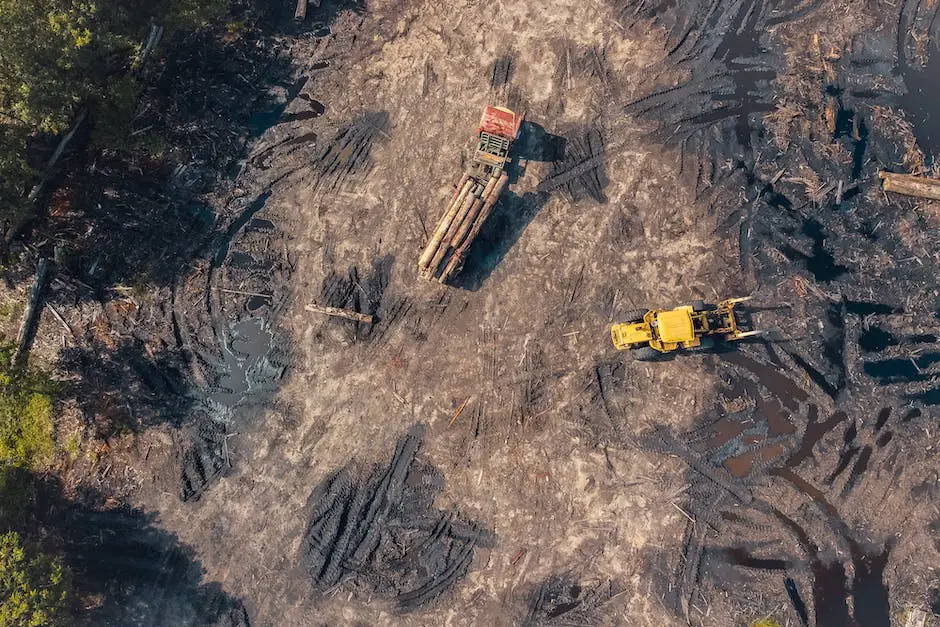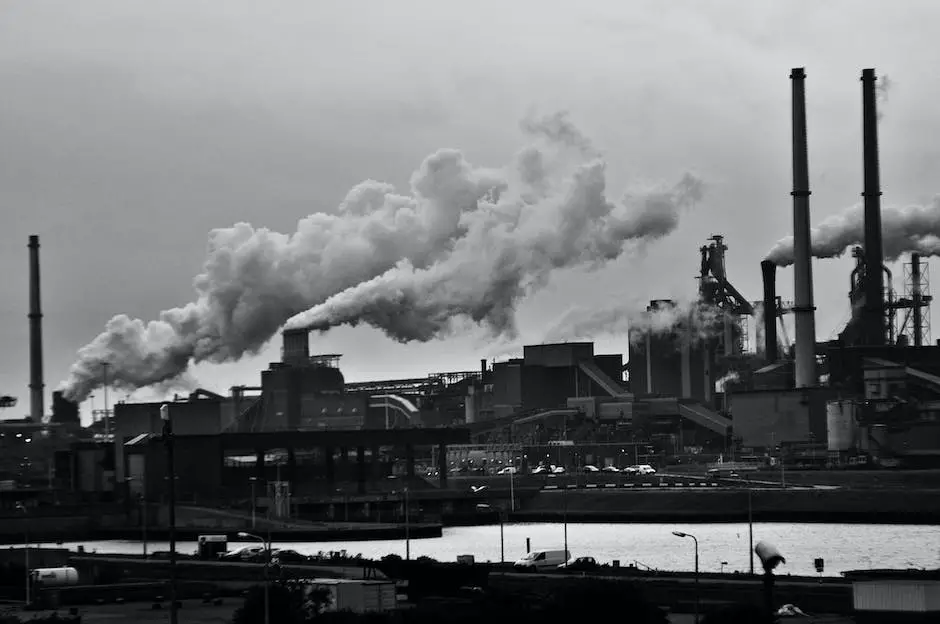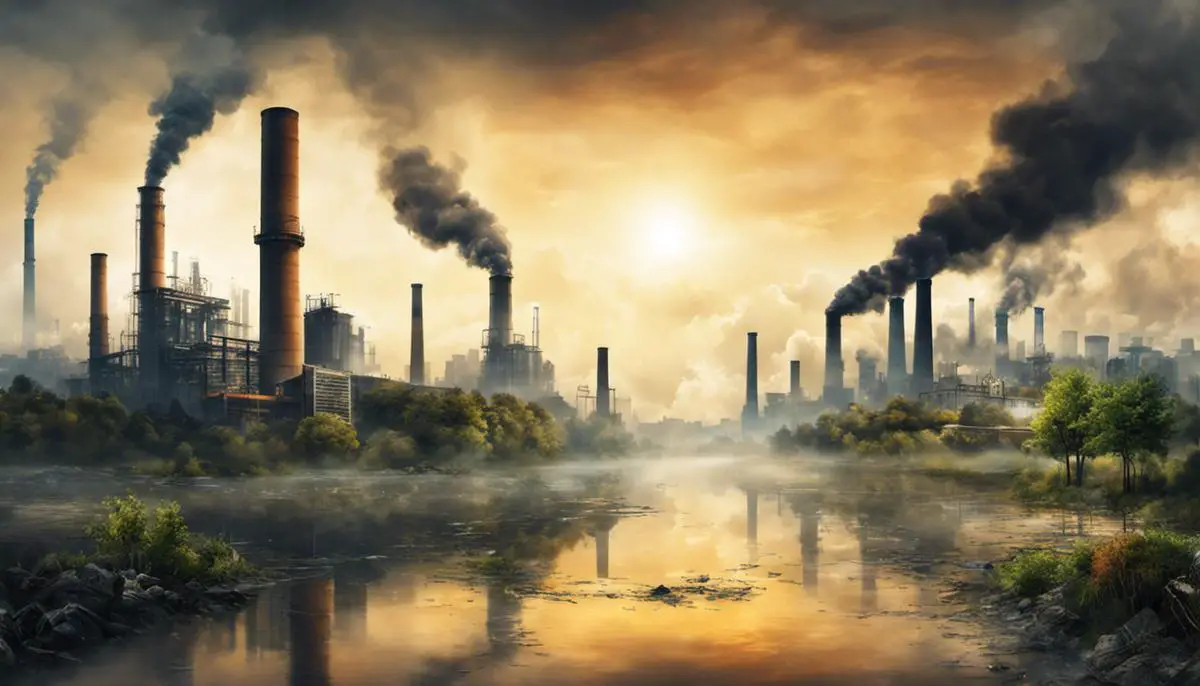Environmental degradation, a pressing issue in our contemporary world, is the deterioration of our planet’s natural environment caused by human activities. Its implications are far-reaching, affecting every stratum of human life and the ecosystems that sustain us. Understanding environmental degradation encompasses a broad scope, from air and water pollution to deforestation and climate change, emphasizing the critical role the environment plays in human survival and wellbeing. This inevitably leads us to confront the unsettling truth of the repercussions of our actions on the environment.
Understanding Environmental Degradation
Understanding Environmental Degradation
Environmental degradation is the deterioration of the natural environment through the depletion of resources, such as air, water, and soil. This deterioration is usually a result of human activities and presents serious threats to sustainable development and the survival of life on earth. Key environmental concerns include air, water and soil pollution, deforestation, climate change, and the depletion of the ozone layer among others.
Causes of Environmental Degradation
Environmental degradation is mostly caused by unsustainable human activities. These can include industrialization, intensification of agriculture, rapid population growth, overuse of natural resources, deforestation, and pollution. All these activities lead to a rapid increase of greenhouse gas emissions, notably carbon dioxide and methane, which intensify global warming.
Types of Environmental Degradation
There are various types of environmental degradation. Air pollution is a major concern, caused by harmful gases, dust, and smoke that enter the air. Soil erosion occurs when the top layer of soil is removed, making it difficult for plants to grow and altering the natural habitat for many animals. Deforestation involves the cutting down of trees, leading to the loss of habitats for the wildlife that lived there, while water pollution occurs when undesirable substances are thrown into bodies of water, contaminating them.
The Impact of Climate Change
Climate change is one of the most destructive types of environmental degradation. The increased levels of greenhouse gases in the earth’s atmosphere lead to global warming, which causes shifts in weather patterns around the world. These changes can lead to more extreme weather events, such as heavy rainfall, floods, droughts, and powerful tropical storms, which can cause widespread destruction and loss of life.
The Depletion of the Ozone Layer
Environmental degradation also stretches to the depletion of the ozone layer. Due to activities such as the use of aerosols and other synthetic chemicals, harmful substances reach the atmosphere and destroy the ozone layer, creating what is commonly known as the ‘ozone hole’. Since the ozone layer plays a key role in blocking out the majority of the Sun’s harmful ultraviolet radiation, its depletion can lead to a range of health problems, from skin cancer and eye damage to immunological disorders.
The Critical Importance of Environment and the Impact of Its Degradation
Essential to human survival and prosperity is the environment, offering indispensable resources such as clean air and water, food, and medicinal supplies. Environmental degradation disturbs these services, potentially triggering distressing cycles of poverty, food scarcity, and conflict. Furthermore, the demolition of natural habitats results in biodiversity reduction, which can interfere with ecosystems and incite the extinction of various species.
The demand for natural resources has significantly increased alongside a booming global population, pushing many species towards extinction and causing loss of habitats. Deforestation, a prime example, doesn’t just pose a threat to wildlife but also elevates the level of CO2 in the atmosphere, enhancing the effects of climate change.
Additionally, environmental degradation triggers massive economic implications. Governments are forced to invest extensively in efforts to purify polluted regions, restore impaired terrains, adapt to and alleviate climate change, and address escalating health concerns.

Direct Consequences of Environmental Degradation
Environmental Degradation and Its Detrimental Health Implications
Environmental degradation poses profound impacts on human health. The compromise in the quality of air, primarily due to industrial pollution, vehicular emissions, and fossil fuel burning, correlates directly to an array of health problems. Respiratory diseases including asthma, bronchitis, and even lung cancer are primarily common among these health issues. On examining, it is evident that such diseases are widespread in heavily industrialized regions across the globe.
Water pollution, another consequence of environmental degradation, carries significant health risks as well. Many industrial processes discharge harmful substances into water bodies, with heavy metals being particularly hazardous due to behaviour such as bioaccumulation and biomagnification. This results in various waterborne diseases when contaminated water is consumed or used for common household purposes. Diseases like dysentery, cholera, and hepatitis persistently occur in areas where the quality of water is compromised.
Impact On Agricultural Practices and Food Production
Soil degradation, encompassing issues of erosion, nutrient depletion, desertification, and soil acidity, has significant implications for agriculture. Unhealthy soil can dramatically reduce the productive capacity of agricultural lands, leading to lower crop yields. This has a notable knock-on effect on food availability, and often the financial stability of farming communities. World Food Programme estimates suggest that about eighty percent of people facing chronic food shortages live in countries where soil degradation is a serious concern.
Biodiversity Loss and Its Implications
Environmental degradation inevitably leads to loss of biodiversity. Habitats are destroyed, often irreversibly, as a result of deforestation, pollution, and other anthropogenic pressures. The loss of any species has ripple effects throughout an ecosystem, affecting its stability and the livelihoods of those who rely on it. Beyond this, some studies suggest that biodiversity loss might be linked to the emergence of zoonotic diseases. Declining biodiversity may make environments more favorable to certain species, many of which can harbor viruses harmful to humans.
Environmental Degradation: Driving Global Warming and Climate Change
One of the most expansive repercussions of environmental degradation is attributable to global warming, which, in turn, prompts climate change. This phenomena primarily stems from the continuous rise in global temperatures, a consequence of our escalating greenhouse gas emissions. This alarming trend is behind the major transformations taking place in our weather patterns and is responsible for the ever-increasing occurrences of severe droughts, fires, heatwaves, storms, and flooding.
Concurrent with the immediate devastation induced by these weather extremes, there exist equally pressing indirect consequences. For instance, escalating heatwaves can lead to lethal heat stress among humans and livestock, while alterations in rainfall distribution can adversely affect crop yields and water availability, especially in monsoon-dependent areas. Forecast of rising sea levels poses a significant risk to coastal residents and regions lying below sea level. The probability of heightened frequency and intensity of storms and cyclones further escalates the vulnerabilities of these communities.

Indirect and Long-term Consequences of Environmental Degradation
Influence of Environmental Degradation on Future Resource Availability
Environmental degradation, encompassing issues like air and water pollution, deforestation, desertification, and biodiversity loss, compromises essential, life-sustaining resources. As we witness the progressive reduction of resources such as pure water and fertile land, challenges related to resource distribution and conservation in the future become a growing concern. A significant consequence of environmental degradation, the loss of biodiversity, endangers the equilibrium and adaptability of ecosystems. The potential repercussions of such effects could lead to the erasure of future resources, for instance, new plant species valuable in medicinal applications, or varieties of crops remain resilient amidst changing climate conditions.
Poverty and Inequality Exacerbated by Regressive Impacts
Environmental degradation disproportionately impacts poorer communities, driving deeper lines of inequality. As environmental quality deteriorates, communities that rely heavily on their environment for livelihood—like farming, fishing, and forestry—find their income sources dwindling. Moreover, these communities often have less access to clean water and healthy food, further compounding their vulnerability. This often results in adverse health consequences, limiting their ability to work and trapping them in a cycle of poverty. It also contributes to widening inequality, as wealthier communities can better shield themselves from environmental degradation effects.
Global Economic Impacts of Environmental Deterioration
Environmental degradation presents significant threats to economies worldwide. It can lead to a stock fall in natural resources, hampering businesses relying on these resources, and increasing commercial costs. For instance, the fishing industry may flounder as fish populations decrease due to water pollution and changing ocean temperatures. Similarly, agriculture can struggle under droughts, floods, and soil depletion. Moreover, expenses related to climate change adaptation straining government budgets, and the healthcare costs associated with pollution are significant.
Conflicts and Forced Migration: Unseen Consequences
Environmental degradation may also indirectly contribute to social unrest, conflict, and forced migration. Resource scarcity, especially of essentials like water and food, can engender territorial disputes and stimulate socio-political instability. For instance, disputes over water resources have been a conflict rationale in arid regions. In addition, extreme weather conditions and natural disasters, exacerbated by environmental degradation, can displace populations, leading to large-scale forced migration. This movement often places additional strain on receiving areas, potentially resulting in social tension and conflict.
Understanding the implications of environmental degradation stresses the immediate need to rectify this issue. The stark consequences range from depleting future resources and exacerbating income inequality, to affecting global economies and indirectly facilitating conflict and forced migration. These widespread repercussions emphasize the importance of supporting sustainable and environmental-friendly strategies to inhibit the degradation process while also alleviating its impacts. In light of this, it becomes clear that all sections of society, the government, and corporations should prioritize eco-conscious practices and policies, acknowledging the significant role of environmental health in ensuring the future’s resilience and prosperity.

Societal Responses and Global Efforts to Mitigate Environmental Degradation
Stepping Up Conservation Efforts Through Governmental Policies
The role of government policies in combating environmental degradation cannot be overstated. Across the globe, various governmental bodies have constructed legislations intending to protect nature, conserve available resources, and control pollution. Notable examples such as the Clean Air and Water Act in the United States, which strictly regulate emissions and water pollution, are an admirable precedent. Such efforts are not confined to one nation, reflecting a unified global pledge to counter environmental degradation. On top of these enforceable regulations, governments are also promoting policies that endorse sustainable practices like providing tax benefits for businesses transitioning into clean energy.
International Agreements and Universal Efforts
Global cooperation is critical in managing environmental degradation as the effects of pollution cross borders. There are several international agreements aimed at protecting the environment. Examples include the Paris Agreement, an international treaty signed in 2016 to combat climate change, and the Montreal Protocol, a global agreement to phase out the production and consumption of ozone-depleting substances. These treaties show that countries, despite their differences, can work together to tackle environmental problems.
Non-Profit Organizations’ Initiatives
Non-profit organizations are at the forefront of advocating for environmental protection and sustainability. These organizations conduct research, lead conservation efforts, develop sustainable solutions, and raise public awareness about the importance of a healthy environment. Give examples include Greenpeace and the World Wildlife Fund (WWF), which are known for launching worldwide projects for environmental conservation and education.
Local Community Responses
Local communities also play a practical and substantial role in fighting environmental degradation. From organizing cleanup drives and tree planting activities to creating conservancy groups and implementing recycling programs, these initiatives can collectively contribute to a larger impact. Local action signifies the power of people to make significant changes in their immediate environment and create a ripple effect to larger spheres.
The Role of Individual Action
Alongside collective efforts, individual actions also matter in mitigating environmental degradation. Lifestyle changes that support sustainability, such as reducing energy consumption, recycling, composting, and mindful consumption can have a significant impact on the environment. Additionally, individuals can influence others in their networks to adopt more sustainable habits, leading to a cumulative effect.
Changing Consumption Patterns
Addressing environmental degradation also requires a shift in consumption patterns. This can manifest in several ways – from favoring products with lesser environmental footprints to supporting companies with green initiatives. Additionally, reducing waste, particularly food waste and single-use plastics, and opting for renewable sources of energy are other ways consumers are changing consumption patterns. This shift reflects a rising global consciousness regarding the environmental consequences of consumption choices.
The urgent need to arrest and reverse environmental degradation has sparked a myriad of societal responses and global efforts. Governments, international bodies, non-profit organizations, and local communities are initiating steps to repair the damage done and prevent further harm. Individual actions and alterations in lifestyle and consumption patterns carry equally significant weight. The collective effort to mitigate environmental degradation is a testament to our capacity for adaptation, innovation, and resilience. As stewards of the planet, the task remains ours to ensure its preservation and longevity for the generations to follow.




